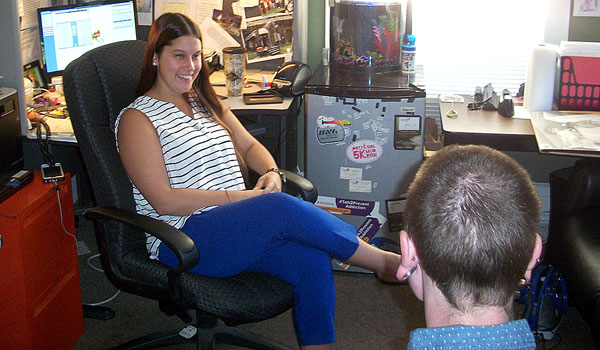Msgr. Carr Institute gives new leases on life toward recovery
by KIMBERLEE SABSHIN
In providing its services to the community, the Chemical Dependency Treatment Program of Catholic Charities' Monsignor Carr Institute in Buffalo is at the forefront of Western New York's fight against an ongoing epidemic of opioid addiction and related deaths. The center provides help for recovering patients, including counseling and Suboxone, a medication prescribed for associated symptoms.
As of last month, Alex, a 23-year-old patient in the program, had been seeing Kelly Andol, LMHC, a counselor at the Monsignor Carr Institute, since February 2015. When he first came in, he had been laid off from his job, his relationships with his loved ones were suffering and he could no longer make ends meet with bills, so he decided to seek help. Four sessions into treatment, he started on the Suboxone program and began seeing a doctor once a week. Over time, he started working and he now has two jobs. His relationship with his family has improved, as has his self-esteem. He did not have a car then, but he has one now.
"I started doing opiates recreationally when I was younger," he recalled. "It went from just doing them here and there, to doing them every day. It turned from a habit to a problem, and eventually I just got to the point where I had no money, my bills weren't paid and the pain just got great enough that I finally wanted to stop. I came here, and I got into the program. I started seeing Kelly right away."
As he progressed in the program, Alex started to see the doctor every other week, and eventually every month. He continues to see Andol twice a week. He had also been attending group sessions, as well as going to outside meetings to supplement the treatment through Catholic Charities.
"They've definitely made it a lot easier. I guess it's one of those things where you have to learn how to walk again, and the things that Kelly's done with me here are things I've known I needed to work on, but I never did," Alex commented. "They make you feel really at home, like they want to help. They don't make you feel like they're trying to rush you out the door or just get the turnover rate up."
Suboxone is prescribed to people suffering from addiction since it works to block the uptake of opiates. "If you have someone on heroin or prescription opiates, it no longer allows them to get high. It blocks their cravings, so what it allows for our patients, which is really big, is that it allows them to become stabilized so they can work on finding a job, stabilizing mental health, building relationships, building coping skills without being extremely sick and having constant cravings," Andol said. "Attendance is really crucial."
While in the program, patients must come to two group sessions per week in the beginning, as well as their individual appointments. The program screens urine to ensure patients are staying clean. Some people taper off, while others switch to another doctor. As of last month, Alex would soon be switching to an outside provider. The program also works with Narcotics Anonymous and Alcoholics Anonymous.
The New York State Office of Alcoholism and Substance Abuse Services oversees its chemical dependency treatment program, with a wide range of services including a suboxone program, and individual and group counseling. Andol, who began her work with the Monsignor Carr Institute as an intern from St. Bonaventure University in 2011, typically sees patients once a week. Maura Beres serves as the coordinator of the Chemical Dependency Treatment Program as the successor of previous director Bernie Arnesen.
"I kind of run the gamut. I work with one of the doctors one day a week, overseeing suboxone, so I talk to the patients beforehand, before the doctor comes in and sees them," said Andol. "My specific groups I do right now are journey through recovery, anger management and stress management. We all have a case load anywhere between 25 and 40 - it can fluctuate - of individual clients to see."
When asked how the program has been able to help Alex, Andol said he had been in "a very bad spot in his life, in a lot of ways," when he first came in. She has watched him and helped him get back to a position where he can work full-time and maintain healthier relationships. "He's a very unique young man," she added. "He's very creative, but he's been able to find himself, and what that means for him. He's found new ways to express himself, and healthier ways to just exist in the world and all the madness it can be."
Andol emphasized the fact that the opioid epidemic in Western New York is a "sad and scary" thing that affects people of all nationalities, races, sexes, ages and socioeconomic groups, and does not discriminate. Andol said she feels the problem will continue until society makes "huge changes in health care," as well as the stigma of addiction and the services provided to people who are suffering from it. Education and knowledge are also crucial to help the general public realize that stereotypes are not accurate.
"There's a stigma in the public, what we think about people with addiction. It's not the people who think it is. It's your neighbor, your brother, your sister, your doctor - and sometimes before they even know it's happening," she added. "I don't know one person I've worked with who's wanted this lifestyle after they have seen the negative consequences, but we're so hateful toward them and judgmental."




